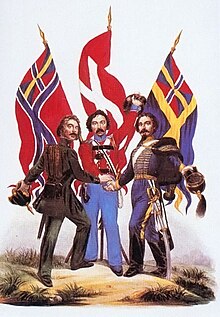Scandinavism


Scandinavism(Danish:skandinavisme;Norwegian:skandinavisme;Swedish:skandinavism), also calledScandinavianism[1]orpan-Scandinavianism,[2]is an ideology that supports various degrees of cooperation among theScandinaviancountries.[3]Scandinavism comprises the literary, linguistic and cultural movement that focuses on promoting a shared Scandinavian past, a shared cultural heritage, a commonScandinavian mythologyand acommon language or dialect continuum(from the common ancestor language ofOld Norse) and which led to the formation of joint periodicals and societies in support of Scandinavian literature and languages.[4]The movement was most popular amongDanesandSwedes.[3]Nordismexpands the scope to includeIcelandandFinland.[5]
History[edit]
According to historian Sverre Bagge, prior to the formation of state-like kingdoms in Scandinavia,[6]
Scandinavia was culturally and linguistically homogeneous. Even in the thirteenth century the term ‘Danish tongue’ was used for the language throughout the area. There were different dialects, but the lines of division between them did not correspond to the later national borders. Religion and customs were also similar, during the pagan as well as the Christian periods. Thus, no cultural or linguistic distinctions prevented unification of each country. Nor, on the other hand, did such distinctions give rise to natural borders between the kingdoms that eventually emerged.
Pan-Scandinavianism as a modern movement originated in the 19th century,[1]but the movement had already begun spreading a century earlier in circles of literature and science.[7]The Pan-Scandinavian movement paralleled the unification movements ofGermanyandItaly.[8]As opposed to the German and Italian counterparts, the Scandinavian state-building project was not successful and is no longer pursued.[2][8]It was at its height in the mid-19th century and supported the idea ofScandinavianunity.[9][1]
The movement was initiated by Danish and Swedish university students in the 1840s, with a base inScania.[10]In the beginning, the political establishments in the two countries, including theabsolute monarchChristian VIIIandCharles XIV Johnwith his "one man government", were suspicious of the movement.[10]The movement was a significant force from 1846 to 1864, however the movement eventually dwindled and only had strong support among theSwedish-speaking population of Finland.[1][11]
The collapse of Pan-Scandinavianism came in 1864 when theSecond Schleswig-Holstein Warbroke out.King Karl XV of Sweden(who was also King Karl IV of Norway), who reigned from 1859 until his death in 1872, in spite of championing Pan-Scandinivianism, failed to helpDenmarkin the war.[12]
AuthorHans Christian Andersenbecame an adherent of Scandinavism after a visit to Sweden in 1837, and committed himself to writing a poem that would convey the relatedness of Swedes, Danes andNorwegians.[13]It was in July 1839, during a visit to the island ofFunenin Denmark, that Andersen first wrote the text of his poem,Jeg er en Skandinav( "I am a Scandinavian" ).[13]Andersen composed the poem to capture "the beauty of the Nordic spirit, the way the three sister nations have gradually grown together", as part of a Scandinavian national anthem.[13]ComposerOtto Lindbladset the poem to music, and the composition was published in January 1840. Its popularity peaked in 1845, after which it was seldom sung.[13]
In 1923, theClara LachmannFoundation was established with the goal of promoting Scandinavian unity through culture.[14][15]
In literature[edit]
TheSherlock Holmesstory "A Scandal in Bohemia"mentions a fictional King of Scandinavia whose daughter is about to marry the (also fictional) King ofBohemia,a major protagonist in the story.
See also[edit]
References[edit]
- ^abcd"Pan-Scandinavianism".Encyclopedia Britannica.Archivedfrom the original on 7 February 2018.
- ^ab"Pan-Scandinavianism"Archived29 September 2007 at theWayback Machine.(2007). InEncyclopædia Britannica.Retrieved April 29, 2007, from Encyclopædia Britannica Online.
- ^ab"Skandinavism"[Scandinavism].ne.se(in Swedish).Nationalencyklopedin.Retrieved1 October2022.
- ^The Literary ScandinavismArchived23 June 2007 at theWayback Machine.Øresundstid, 2003. Retrieved 6 May 2007.
- ^"Nordism".nordics.info.Aarhus University.10 August 2021.Retrieved31 August2021.
- ^Bagge, Sverre (2009).Early state formation in Scandinavia.Vol. 16. Austrian Academy of Sciences Press. p. 145.ISBN978-3-7001-6604-7.JSTORj.ctt3fgk28.
- ^Nordisk familjebok(in Swedish). Stockholm: Nordisk familjeboks förlags aktiebolag. 1917. pp. 879–882.Retrieved1 October2022– viaProject Runeberg.
- ^abOla Tunander(1999)."Nordic cooperation",UDA085ENG. InNytt fra Norge, ODIN – Information from the government and the ministries,Ministry of Foreign Affairs, Norway. See also Tunander, Ola (1999). "Norway, Sweden and Nordic cooperation". InThe European North – Hard, soft and civic security.Eds. Lassi Heininen and Gunnar Lassinantti. The Olof Palme International Center/Arctic Centre, University of Lapland, 1999. pp. 39–48.ISBN951-634-690-1.
- ^J. P. T Bury (3 January 1960).The New Cambridge Modern History: Volume 10.CUP Archive.ISBN9780521045483.Archivedfrom the original on 14 April 2018.
- ^abThe StudentsArchived13 August 2007 at theWayback Machine.Øresundstid, 2003. Retrieved 6 May 2007.
- ^"Charles XV".Encyclopedia Britannica.Archivedfrom the original on 12 October 2017.
- ^"About Pan-Scandinavianism. Reference Points in the 19th Century (1815-1864)".academia.edu.Archivedfrom the original on 17 March 2016.
- ^Kjellander, Rune (1979)."Clara Lachmann".Dictionary of Swedish National Biography(in Swedish). Vol. 22. p. 23.
- ^"Stiftelsens historik"[The Foundation's History].Clara Lachmanns Stiftelse(in Swedish).Retrieved2024-06-10.
Further reading[edit]
- Hilson, Mary.Denmark, Norway, and Sweden: Pan-Scandinavianism and Nationalism.University of Portsmouth.Archivedfrom the original on 2018-04-14.
- 'Pan-Scandinavianism. Reference Points in the 19th Century (1815-1864)' by Mircea-Cristian Ghenghea
External links[edit]
- The Helsinki Treaty of 1962Archived2014-05-30 at theWayback MachineNicknamed as constitution of the Nordic Countries.
- Jeg er en Skandinav.A rendition of H. C. Andersen's poem, set to Otto Lindblad's music.
